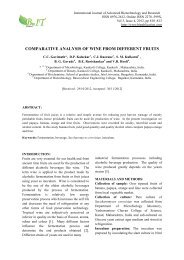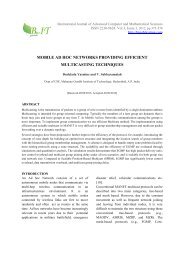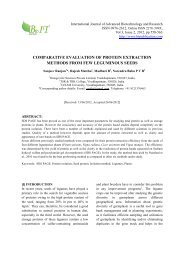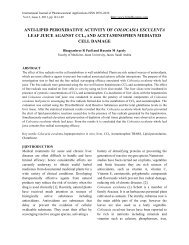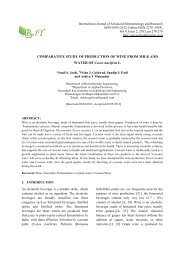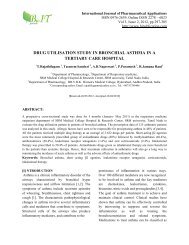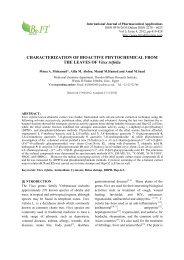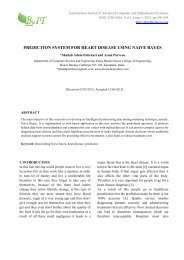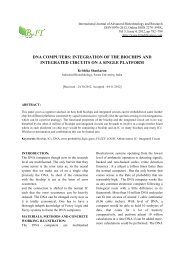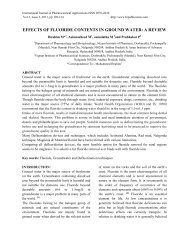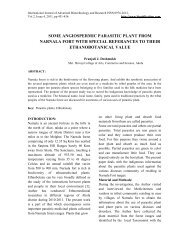influence of nitrogen sources and agitation in xanthan gum - BioIT ...
influence of nitrogen sources and agitation in xanthan gum - BioIT ...
influence of nitrogen sources and agitation in xanthan gum - BioIT ...
You also want an ePaper? Increase the reach of your titles
YUMPU automatically turns print PDFs into web optimized ePapers that Google loves.
INFLUENCE OF NITROGEN SOURCES AND AGITATION IN XANTHAN GUM300 rpm production levels on <strong>in</strong>creas<strong>in</strong>g thestirrer speed beyond 400 rpm, <strong>xanthan</strong> productionappeared to depend on <strong>agitation</strong>, withsignificantly <strong>in</strong>creas<strong>in</strong>g concentrations with<strong>in</strong>creased stirrer speeds. The optimum <strong>agitation</strong>was found to be at 500 rpm <strong>and</strong> the yield <strong>of</strong><strong>xanthan</strong> was 3.62 g/L.Fig. 3. Xanthan <strong>gum</strong> yield <strong>and</strong> biomass productionfrom yeast extract3.3. Batch fermentationTo exam<strong>in</strong>e the pattern <strong>of</strong> the <strong>xanthan</strong> production<strong>in</strong> detail, batch fermentations were carried out <strong>in</strong>a jar fermentor. [Figure-1] shows the yield<strong>xanthan</strong> <strong>gum</strong> from various <strong>nitrogen</strong> <strong>sources</strong> used<strong>in</strong> batch fermentation at 500 rpm. The yeastextract gave the maximum production <strong>of</strong> <strong>xanthan</strong>,3.6 g/L at 500 rpm. Xanthan production showedthe same pr<strong>of</strong>ile with the cell growth. It was alsonoted that no further <strong>xanthan</strong> was produced after<strong>nitrogen</strong> <strong>sources</strong> were exhausted <strong>and</strong> the yeastextract concentration fell below 40 g/L shown <strong>in</strong>[Table-2].Yeast extract Xanthan <strong>gum</strong> Biomassconcentration yield (g L -1 ) production(g/L)(g/L)1 3.0 5.22 2.6 4.53 3.6 5.64 2.9 4.5Table 2. Yield <strong>of</strong> <strong>xanthan</strong> <strong>gum</strong> <strong>and</strong> biomassproduction from yeast extract3.4. Fed-batch fermentationResults obta<strong>in</strong>ed from the batch cultivation led usto carry out a fed-batch fermentation to promotethe <strong>xanthan</strong> production by add<strong>in</strong>g glucose <strong>and</strong>yeast extract before they decl<strong>in</strong>ed at certa<strong>in</strong>concentrations. Dissolved oxygen concentrationwas also ma<strong>in</strong>ta<strong>in</strong>ed above 10 % air saturationdur<strong>in</strong>g the <strong>xanthan</strong> production by shift-up the<strong>agitation</strong> speed. Cell concentration <strong>and</strong> <strong>xanthan</strong>concentration cont<strong>in</strong>ued to <strong>in</strong>crease whensufficient <strong>nitrogen</strong> <strong>and</strong> carbon were supplied. Theyield <strong>of</strong> <strong>xanthan</strong> <strong>gum</strong> produced from fed batchfermentation was 5.2 g/L. In the fed batch mode<strong>of</strong> fermentation the addition <strong>of</strong> substrates atregular <strong>in</strong>tervals improved the xathan production.This was due to the reduction/elim<strong>in</strong>ation <strong>of</strong>catabolite repression due to the controlled feed<strong>in</strong>g<strong>of</strong> substrate which would otherwise had turned onthe fermentative path way lead<strong>in</strong>g to fermentativeproducts because <strong>of</strong> excess <strong>of</strong> glucose <strong>in</strong> themedium.[IV] CONCLUSIONThe optimization <strong>and</strong> production <strong>of</strong> the <strong>xanthan</strong><strong>gum</strong> with different <strong>nitrogen</strong> <strong>sources</strong> such as theurid dhal, toor dhal, green gram <strong>and</strong> yeast extractwere compared <strong>and</strong> yeast extract showed highest<strong>xanthan</strong> <strong>gum</strong> production <strong>of</strong> 0.36 g/100 mL whileUrid dhal gave 0.27g/100 mL, toor dhal gave0.22g/100 mL, <strong>and</strong> green gram gave 0.21g/100mL.Different <strong>agitation</strong> speed such as 300 rpm, 400rpm, 500 rpm, <strong>and</strong> 600 rpm was optimized for<strong>xanthan</strong> <strong>gum</strong> production with yeast extract <strong>and</strong>the optimum production was found at 500 rpm.References1. Milas M, Reed WF, Pr<strong>in</strong>tz S, [1996]Conformations <strong>and</strong> flexibility <strong>of</strong> native <strong>and</strong> renatured<strong>xanthan</strong> <strong>in</strong> aqueous solutions, Int. J. Biol.Macromol. 18:211-221.2. Sutherl<strong>and</strong> IW, [1996] Extracellularpolysaccharides. In: Biotechnology, vol 6, 2 nd ed.,(Rehm HJ <strong>and</strong> G Reed, Eds.) VCH, We<strong>in</strong>heim,pp. 613-657Aarthy Palaniraj et al. 308



